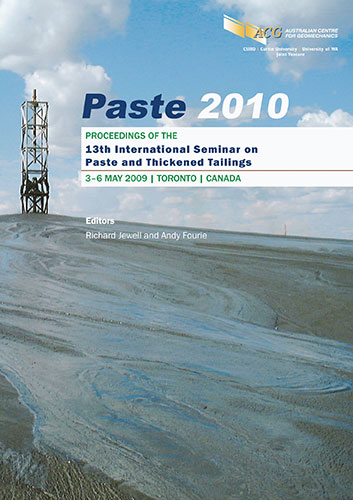Paste backfill — adding value to underground mining

|
Authors: Slade, NM |
DOI https://doi.org/10.36487/ACG_rep/1063_9_Slade
Cite As:
Slade, NM 2010, 'Paste backfill — adding value to underground mining', in R Jewell & AB Fourie (eds), Paste 2010: Proceedings of the Thirteenth International Seminar on Paste and Thickened Tailings, Australian Centre for Geomechanics, Perth, pp. 99-109, https://doi.org/10.36487/ACG_rep/1063_9_Slade
Abstract:
The application of paste as backfill in underground mines has been demonstrated in a variety of mining operations to create advantages in delivering improved production rates and reduced operating costs, providing an opportunity to add value to the business. This can deliver short term gains to an operation as well as enable longer term strategic goals to be enhanced. An underground mine normally uses backfill to assist in maximising the recovery of the ore in the mine, as the value of the material processed, refined and sold offsets the cost of the backfill placed. In addition this also allows the mine to recover more of the Mineral Resource, creating an opportunity to increase the Ore Reserve. Historically backfill has tended to be sand and cement placed as a slurry into the mine stope. This is often referred to as cemented hydraulic fill. Variants to this are also used including the placement of additional aggregate and/or rock into the stope with the cemented sand slurry. This paper describes the differing range of backfill materials used in underground mines and highlights the merits of paste backfill from various perspectives of value, cost, operations and ore production scheduling. The paper goes on to describe a case study of the use of two differing backfill materials and describes the financial, mine design, ore reserve and scheduling attributes that deliver additional value to a given underground mining operation.
References:
Bloss, M.L., Cowling, R. and Meek, J.L. (1993) A procedure for the design of stable cemented fill exposures, in
Proceedings Minefill 93, South African Institute of Mining and Metallurgy, Johannesburg, South Africa.
Li, T., Singh, U., Coxon, J., Grice, T. and Sainsbury, D. (2002) Development and application of paste fill using dry
tailings, in Proceedings First International Seminar on Deep and High Stress Mining, Australian Centre for
Geomechanics, Perth, Australia, Section 12.
Runge, I. (1998) Mining economics and strategy, Society for Mining, Metallurgy and Exploration Incorporated, United
States.
Slade, N.M., Felipe, F., Wilson, S. and Palkovits, F. (2009) Increasing Value in Mining Operations through the
Application of Paste, in Proceedings 13th AusIMM Mill Operators Conference, Australian Institute for Mining
and Metallurgy, Adelaide, Australia.
Slade, N.M., Guilfoyle, K. and Kropp, W. (2006) Strategic and tactical mine planning in Enterprise Mine, Mount Isa
Copper Operations, in Proceedings Strategic versus Tactical Approaches in Mining, Australian Centre for
Geomechanics, Perth, Australia, Section 39.
Paste backfill — adding value to underground mining N.M. Slade
110 Paste 2010, Toronto, Canada
© Copyright 2025, Australian Centre for Geomechanics (ACG), The University of Western Australia. All rights reserved.
View copyright/legal information
Please direct any queries or error reports to repository-acg@uwa.edu.au
View copyright/legal information
Please direct any queries or error reports to repository-acg@uwa.edu.au